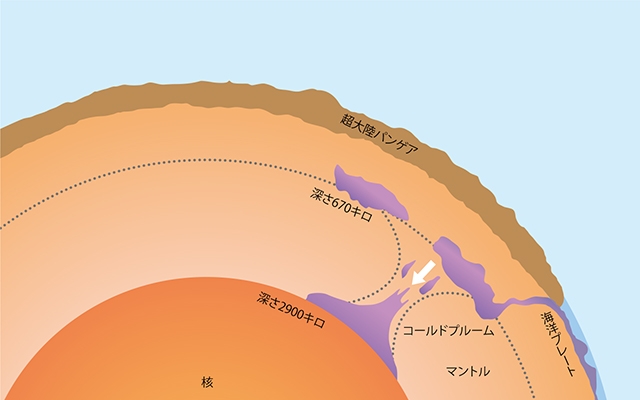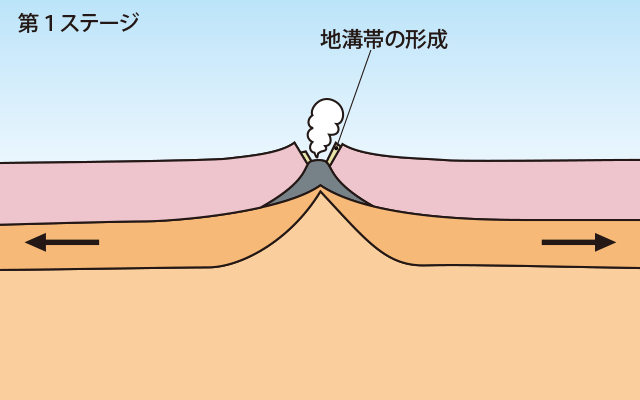
ホットプルームとコールドプルーム
Hot plume and cold plume

ウィルソンサイクル
Wilson cycle
石炭紀からペルム紀にかけては、もともと巨大なユーラメリカ大陸とゴンドワナ大陸がゆっくりと接近・合体し、さらに大きな1つの超大陸パンゲアが形成された。過去の地球で起きた現象の多くは繰り返し(サイクル)で特徴づけられる。気候が寒冷と温暖の間で繰り返し(☞E5_2ページ)、生物が絶滅と繁栄を繰り返してきたように(☞E4_2ページ)、大陸も分裂と集合を繰り返してきた。ここでは、ウィルソン・サイクルと呼ばれるそのメカニズムを説明しよう。
地中深くのマントル内には大規模な対流があり、地表に向かって上昇するホットプルームと、地球の深部(核)に向かって沈み込むコールドプルームが存在する(図)。ウィルソン・サイクルの第1ステージには、ホットプルームが活発化して上昇し、地表に到達することで大陸に裂け目が生じる。第2ステージには、裂け目が拡大することで大陸が2つに分かれ、それらの間に新しい海が形成される。第3ステージには、ホットプルームの上昇部に海嶺ができ、そこから新しい海洋プレートが次々に生産されて海が拡大する(☞E1_6ページ)。第4ステージには、大陸プレートの縁辺で破壊が生じ、比較的重い海洋プレートがその下に潜り込んで沈み込み帯が形成される。第5ステージには、海嶺における海洋プレートの生産力が落ち、その海嶺自体も沈み込み帯に飲み込まれることで海が縮小してゆく(海の両端にある大陸は近づいてゆく)。最後の第6ステージでは、海が完全に消滅し、2つの大陸が衝突・合体して超大陸が形成される。また、この時期に大陸同士の衝突部には山脈が形成される(☞E1_6ページ)。
ちなみに、第4〜6ステージで沈み込み帯に飲み込まれた海洋プレートは、いったん深さ約670kmの場所に集積した後、コールドプルームとなって深部の核に沈み込んでゆく。その反動で第1ステージのホットプルームが形成される。ウィルソン・サイクル(第1〜6ステージ)は約3〜4億年で一周する。
ウィルソン・サイクルの過程で誕生した超大陸は研究者間で意見が異なるが、例えばバールバラ大陸(☞E1_6ページ)、ヌーナ大陸(19億年前)やコロンビア大陸(18〜15億年前)、ロディニア大陸(10〜6億年前)、パンゲア大陸が知られている。そして遠い未来にも超大陸は再び出現するはずである(☞?ページ)。
From the beginning of the Carboniferous to the Permian, the giant Euramerica continent and Gondwana continent slowly approached and fusionned in an even larger supercontinent called Pangea. As we saw previously, many of the phenomena that occurred during Earth's past will repeat and are called cycles. Just like mild climate changed many times to glaciation (page ☞E5_2), or just like living organisms repeatedly died out to become even more prosperous (page ☞E4_2), continents split and gathered many times. Let see how these mechanisms called "Wilson cycles" work.
The deep underground mantel is the theater of a large-scale convection, where hot plumes (upwelling plume) rise towards the surface and where cold plumes (downwelling plume) sink toward the center (nucleus) of the Earth (figure). In the first stage of the Wilson cycle, the hot plume is activated and increases, creating a crack in the continent when reaching the surface.
In the second stage, the continent is divided in two by the expansion of the cracks, and a new sea is formed between these two continents.
In the third stage, a ridge is formed in the upper part of the hot plume, allowing the ocean to expand by producing one after another new oceanic plates (☞E1_6 page).
In the fourth stage, destruction occurs at the edge of the continental plate and the relatively heavy oceanic plate goes underneath the continental plate to form a subduction zone.
In the 5th stage, the oceanic plate production diminishes, the oceanic ridge itself is also swallowed by the subduction zone and the sea shrinks (the continent situated at both ends of the sea get closer).
In the final 6th stage, the ocean basin is completely destroyed by a continental collision which completes the mountain building process, and forms a supercontinent (☞ page 1 - 6). Incidentally, the oceanic plate swallowed by subduction between the 4th and 6th stage, once accumulated somewhere at about 670km in depth becomes a cold plume and sinks toward the nucleus. In reaction, the 1st stage hot plume is formed. One complete Wilson cycle (from stage 1 to 6) is said to take between 300 and 400 million years.
Supercontinents born from Wilson cycle are still subject of debate among the scientific community however we can name the Vaalbara supercontinent, the Nuna supercontinent also known as Columbia supercontinent (-1,9 billion YA), the Rodinia supercontinent (1000 to 600 MYA) and the Pangea supercontinent. In a distant future, a new supercontinent should form again (☞? Page).